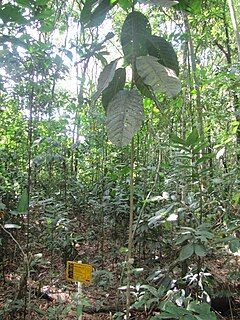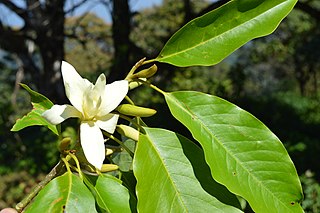
Magnolia acuminata, commonly called the cucumber tree, cucumber magnolia or blue magnolia, is one of the largest magnolias, and one of the cold-hardiest. It is a large forest tree of the Eastern United States and Southern Ontario in Canada. It is a tree that tends to occur singly as scattered specimens, rather than in groves.

Magnolia virginiana, most commonly known as sweetbay magnolia, or merely sweetbay, is a member of the magnolia family, Magnoliaceae. It was the first magnolia to be scientifically described under modern rules of botanical nomenclature, and is the type species of the genus Magnolia; as Magnolia is also the type genus of all flowering plants (magnoliophytes), this species in a sense typifies all flowering plants.

Magnolia wilsonii, or Wilson's magnolia, is a species of Magnolia native to China, in the provinces of western Guizhou, Sichuan and northern Yunnan, where it grows in the forest understory at altitudes of 1,900-3,000 m, rarely up to 3,300 m.

Magnolia officinalis is a species of Magnolia native to the mountains and valleys of China at altitudes of 300–1500 m.

The military macaw is a large parrot and a medium-sized macaw that gets its name from its predominantly green plumage resembling a military parade uniform. It is native to forests of Mexico and South America and though considered vulnerable in the wild, it is still commonly found in the pet trade industry.

Microberlinia bisulcata is a species of plant in the family Fabaceae, a lowland rainforest tree that is found only in Cameroon. It is threatened by habitat destruction and exploitation. Common names include African zebrawood, tigerwood, zebrano and zingana.
Podocarpus celatus is a species of conifer in the family Podocarpaceae. It is found in the Amazon rainforest.

Hamptophryne boliviana, also known as the Bolivian bleating frog or Amazon sheep frog, is a species of frogs in the family Microhylidae. It is found in the northern and western sides of the Amazon basin in Bolivia, Brazil, Colombia, Ecuador, French Guiana, Guyana, Peru, Suriname, and Venezuela. Genetic analysis suggests hidden diversity within the nominal species.

Magnolia dealbata is a species of flowering plant in the family Magnoliaceae. It is known commonly as the cloudforest magnolia and eleoxochitl. It is sometimes considered to be a subspecies of Magnolia macrophylla.
Magnolia espinalii is a species of plant in the family Magnoliaceae. It is endemic to Colombia but critically endangered. According to López-A et al., as of 2008 there were only 23 known surviving trees in the wild. Common names include: hojarasco, magnolio de monte.
Magnolia guatapensis is a species of plant in the family Magnoliaceae. It is endemic to Colombia. Common names include: almanegra, almanegra de Guatapé.

Magnolia hernandezii is a species of plant in the family Magnoliaceae. It is endemic to Colombia. The tree can attain an height of up to 40 m and trunk diameter approaching 1 m with smooth, light-brown or light-grey bark. It has a woody, globular fruit with up to 15 cm diameter.

Magnolia rostrata, the beaked magnolia, is a species of plant in the family Magnoliaceae. It is found in the Himalayas. It is an IUCN Red List endangered species, threatened by habitat loss.
Magnolia yoroconte is a species of tree in the family Magnoliaceae. It is found in Guatemala, Belize and Honduras.
Magnolia dixonii is a species of flowering plant in the family Magnoliaceae. It is endemic to Ecuador. It is known commonly as cucharillo.

Isiboro Sécure National Park and Indigenous Territory is a protected area and Native Community Land in Bolivia situated between the north of the Cochabamba Department and the south of the Beni Department. It protects part of the Bolivian Yungas ecoregion. The indigenous people living within the park belong to the Tsimané, Yuracaré, and Mojeño-Trinitario peoples. The southern portion of the park has been colonized by agricultural settlers, primarily coca farmers, since the 1970s. The Bolivian government estimates that 10% of the park has been deforested by their presence.

Magnolia liliifera, commonly known as egg magnolia, is a flowering tree native to the Indomalayan realm. It bears white to cream-colored flowers on terminal stems. The leaves are elliptical and get as large as 25 cm (10 in) long and 8 cm (3 in) wide. The tree ranges in height from 3.5 to 18.5 m in situ.

Magnolia nilagirica is a species of plant in the family Magnoliaceae. It is a tree that is threatened by habitat loss, endemic to the Western Ghats of India, and also Sri Lanka.
Magnolia sulawesiana is a large evergreen tree of the family Magnoliaceae that grows in tropical montane forests on the Indonesian island of Sulawesi.

Eucalyptus boliviana, commonly known as Bolivia Hill stringybark or Bolivia stringybark is a shrub or a mallee, sometimes a small tree and is endemic to a small area in northern New South Wales. It is a stringybark with four-sides stems, broadly lance-shaped adult leaves, flower buds arranged in groups of seven, yellow flowers and hemispherical to broadly funnel-shaped fruit.














